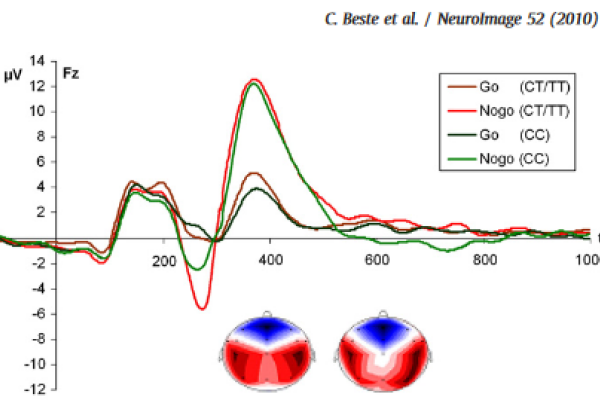2010-04-24

The basal ganglia are connected to prefrontal cortical areas via different functional loops. These loops do not only differ with respect to their cognitive functions the mediate, but also on a neurochemical level. In the current study we ask, how these differences on a neurobiochemical level may affect cognitive processes mediated by these loops. One function of the anterior-cingulate loop is error processing. One function of the orbito-frontal loop is response inhibition. Combining a genetic approach with event-related potential (ERP) measurements of response inhibition (OFC-loop function) and error processing (ACC-loop function), we provide robust results showing a selective modulation of response inhibition processes by the GRIN2B C2664T polymorphism at the behavioural and neurophysiological level. Since error processing functions were not affected, the results suggest for differential influences of the GRIN2B C2664T polymorphism on response inhibition and error processing functions. The results provide first insight into cognitive-neurophysiological effects of the GRIN2B C2664T polymorphism. The dissociation obtained may be due to a differential importance of N-methyl-d-aspartate receptors for glutamatergic neural transmission in different striatal compartments (matrix and striosomes). We provide a model on this that may be a target for future research.

The basal ganglia are connected to prefrontal cortical areas via different functional loops. These loops do not only differ with respect to their cognitive functions the mediate, but also on a neurochemical level. In the current study we ask, how these differences on a neurobiochemical level may affect cognitive processes mediated by these loops. One function of the anterior-cingulate loop is error processing. One function of the orbito-frontal loop is response inhibition. Combining a genetic approach with event-related potential (ERP) measurements of response inhibition (OFC-loop function) and error processing (ACC-loop function), we provide robust results showing a selective modulation of response inhibition processes by the GRIN2B C2664T polymorphism at the behavioural and neurophysiological level. Since error processing functions were not affected, the results suggest for differential influences of the GRIN2B C2664T polymorphism on response inhibition and error processing functions. The results provide first insight into cognitive-neurophysiological effects of the GRIN2B C2664T polymorphism. The dissociation obtained may be due to a differential importance of N-methyl-d-aspartate receptors for glutamatergic neural transmission in different striatal compartments (matrix and striosomes). We provide a model on this that may be a target for future research.